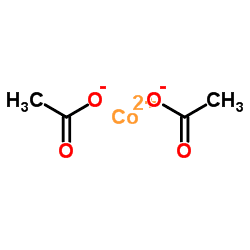Formula C4H6CoO4 Density 1.71 g/cm³ | Melting point 140 °C | |
 | ||
Appearance Pink crystals (anhydrous); intense red crystals (tetrahydrate) | ||
Cobalt(II) acetate is the cobalt(II) salt of acetic acid. It is commonly found as the tetrahydrate Co(C2H3O2)2·4 H2O or Co(CH3COO)2·4 H2O also abbreviated Co(OAc)2·4 H2O. It is used as an industrial catalyst.
Contents
Synthesis and structure
It may be formed by the reaction between cobalt oxide or hydroxide and acetic acid:
CoO + 2 HC2H3O2 + 3 H2O → Co(C2H3O2)2·4 H2OThe tetrahydrate has been shown by X-ray crystallography to adopt an octahedral structure, the central cobalt centre being coordinated by four water molecules and two acetate ligands.
Reactions and uses
Cobalt acetate is a precursor to various oil drying agents, catalysts that allow paints and varnishes to harden. Cobalt(II) acetate reacts with salenH2 to give salcomine, a transition metal dioxygen complex:
Co(OAc)2 + salenH2 → Co(salen) + 2 HOAcSafety
Cobalt salts are poisonous.
References
Cobalt(II) acetate Wikipedia(Text) CC BY-SA
